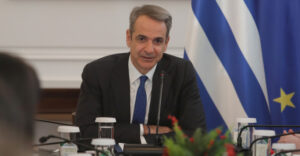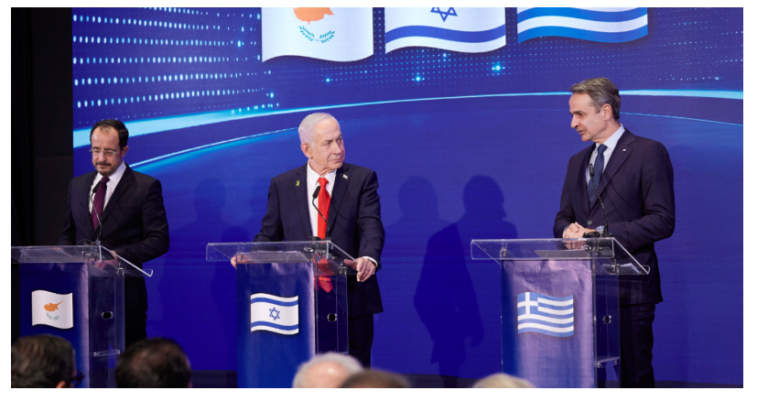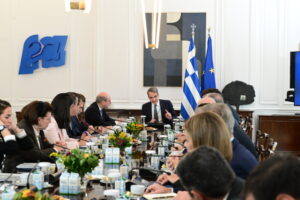As the legendary song by Giorgos Dalaras goes, “Governments fall, but love remains.” Something similar can be said about Lina Mendoni’s case. Steadfast in the leadership of the Ministry of Culture. Governments change, but Mendoni remains.
Since 1999, under the government of Simitis, as the General Secretary of the Ministry, until… tomorrow. With a break of about 5 years, when the so-called left-wing governed the country. No, they didn’t fire her, she made sure to resign and return to her position at the National Hellenic Research Foundation. And if she is replaced? An unbelievable thing, but never say never, then what? “If tomorrow morning I stop holding the position I have today, I will return to my job there.”
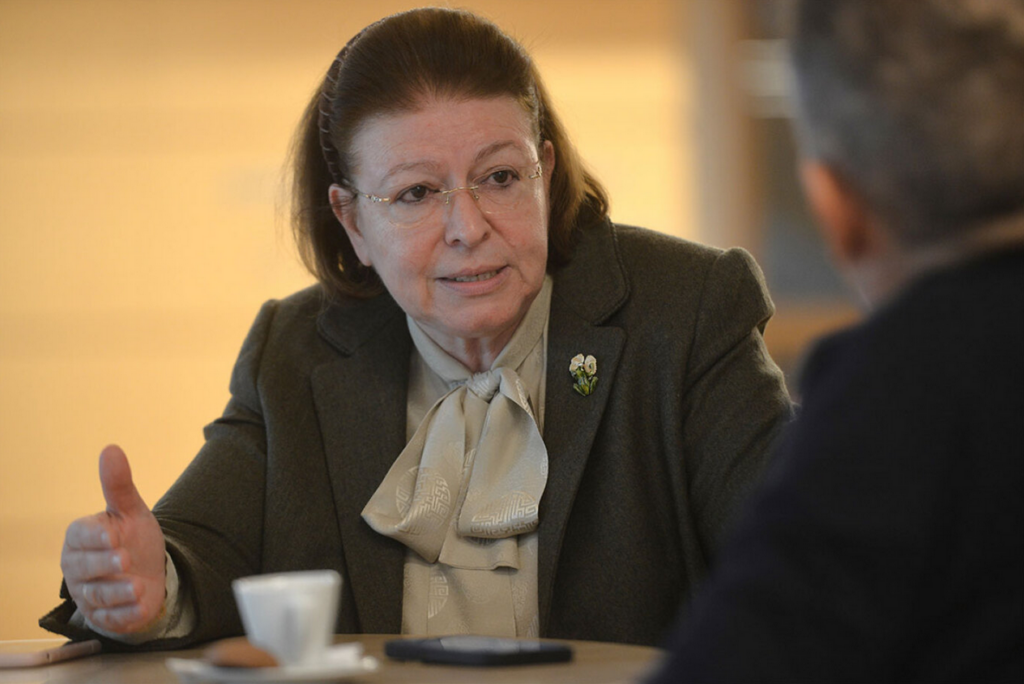
What is the secret of her success? Well, of course, her exceptional knowledge and impressive effectiveness on matters, primarily archaeological. Mendoni, in the blink of an eye, solved the Gordian knot for the Hellinikon project. What others couldn’t do, she managed. Unbelievable. The same goes for the case of the archaeological finds at the Venizelos Station of the Thessaloniki metro. Pat, cut. She sprays, wipes, and finishes.
That’s why I, loaded with many questions but also some reservations regarding modern culture, hurried to meet her in person. The meeting, where else? At the café of the Pinakothiki. Mendoni, me, the Parthenon Marbles, the Venizelos Station, and many others…
Scene 1: “The blessing of our homeland”
DIMITRIS DANIKAS: How many hours do you work per day?
LINA MENDONI: The average is more than 15-16 hours. Of course, some days I’m in the office, and other days I’m on tours across Greece. Not just to museums. I visit construction sites. The Ministry of Culture has at least one service in every region of Greece. Every service has its daily tasks, the permits for citizens’ requests, but also very important works for the protection, maintenance, enhancement, and restoration of monuments in each area. Our country is blessed to have more than 22,000 archaeological sites and monuments. And this is something dynamic. For example, before the Thessaloniki metro was built, before the construction lines were drawn, we didn’t know about the important monuments that were revealed.
D.D.: What was found there?
L.M.: The construction phases of Thessaloniki, from its founding in 316 BC by Cassander, to modern Thessaloniki of the 20th century. Nine meters of fill were excavated. This means that the Ministry of Culture’s services recorded all the traces of Thessaloniki, from the fire of 1917 to, as I said, 316 BC.
The Venizelos Station presents, in its visible phase, the crossroads of two of Thessaloniki’s streets, the Decumanus Maximus and the Cardo, along with their porticos, squares, and buildings—public and private—from the first Byzantine centuries. What’s very important is that the Venizelos Station is located in the historical center of Thessaloniki. Exactly above it are the two streets, Egnatia Avenue and Venizelos Street, which intersect at the station. The same intersection, the same streets, have existed almost in the same spot, with the same layout, since the 3rd century BC. If you think about it, this is mind-blowing for the history and archaeology of the city.
Scene 2: “I solved the Ellinikon problem in a few months”
D.D.: Was it a childhood obsession with archaeology?
L.M.: Look, I always remember myself having two interests. One was archaeology, and the other was medicine. I really enjoyed studying ancient literature, and from my house, from a very young age, my parents made sure we visited archaeological sites and museums.
D.D.: And then you ended up at the Ministry of Culture.
L.M.: I never worked as a civil servant at the Ministry of Culture. My position was at the National Hellenic Research Foundation. So I followed archaeological research. That means, if tomorrow morning I stop holding the position I have today, I will return to my work there.
D.D.: And from there, who chose you to go to the Ministry of Culture? I believe this happened during the PASOK government.
L.M.: Yes, it was the Simitis government when Elisavet Papazoi became Minister of Culture. She knew me from the Cyclades—she was a MP for the Cyclades, and my research field was the Cyclades. She knew me and recommended to the prime minister that I take the position of General Secretary. This happened in 1999. I remained General Secretary at the Ministry until March 2004. I returned in 2009 and stayed until January 2015, when the elections took place and SYRIZA won.
D.D.: Did SYRIZA push you out?
L.M.: No, I resigned immediately, the day after the elections. I returned to the National Hellenic Research Foundation and came back with Kyriakos Mitsotakis’ prime ministership, who honored me by proposing I take the Ministry.
D.D.: An excellent choice, you solved the Hellinikon problem in… a few seconds.
L.M.: In a few months.
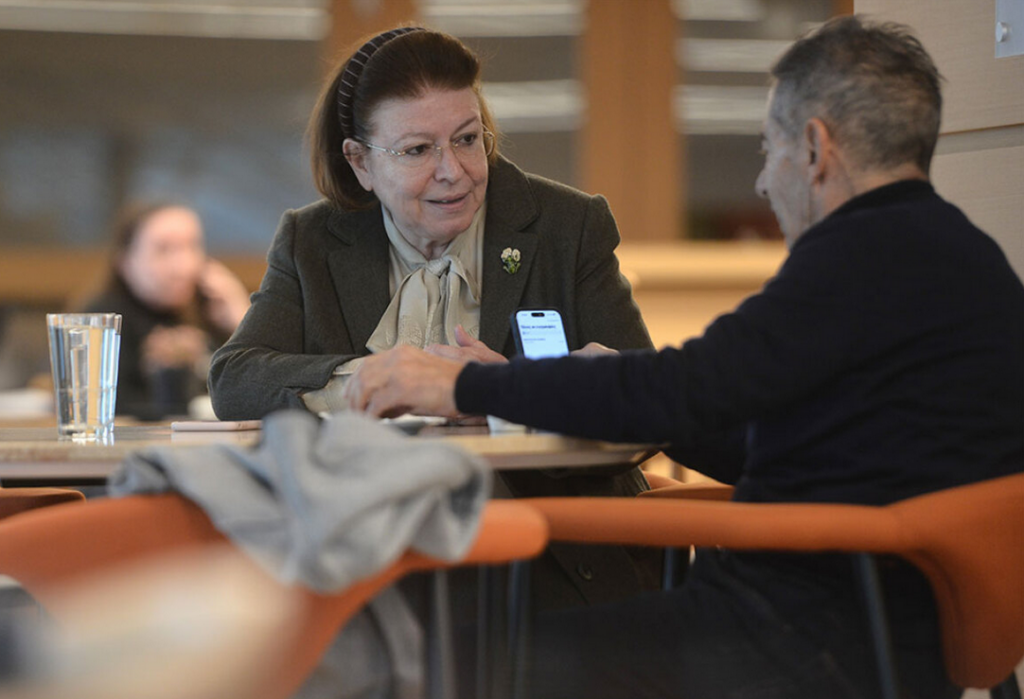
Scene 3: “Elgin didn’t just steal…”
DIMITRIS DANIKAS: However, you carry a very heavy burden, a comparison with Melina Mercouri.
LINA MENDONI: Melina was Melina. The charismatic personality that you knew as well. I also had the privilege of knowing her closely.
D.D.: She was the one who started the campaign for the Marbles. Truly, do we say Marbles or Sculptures?
L.M.: Sculptures. The marble…
D.D.: To return to Melina, she was the one who first raised the issue of the return of the Sculptures, right?
L.M.: Of course, in 1982 at the UNESCO conference in Mexico. Melina made it public.
D.D.: Was it her idea?
L.M.: The request for the return of the Parthenon Sculptures dates back immediately after the Revolution. Right after the founding of the modern Greek state, in 1830, the request for their return was made. And it has been repeated over time. Melina is the one who, in the final phase, if you will, of the Metapolitefsi (post-dictatorship era), raised the issue internationally and emphatically. And exactly because Melina was this charismatic personality, it took on huge proportions.
D.D.: We don’t say “return.”
L.M.: We now talk about reunification. That is the correct term.
D.D.: Reunification, I like that, very catchy.
L.M.: We don’t just want to take them back. We want to reunite them with the parts of the sculptural decoration that we have at the Acropolis. In recent years, many archaeological finds have been returned to their countries of origin. Because the ethics of museums have changed a lot, but also the perception of both civil society and the scientific community regarding cultural assets, which are forcibly removed from the land of the country that created them.
D.D.: They steal, they plunder.
L.M.: The “forcibly” is even stronger than plundering, and I’ll tell you why. Elgin could have stolen a metope. Here, he didn’t just steal it. He cut it. And he destroyed it.
D.D.: He desecrated it.
L.M.: Exactly. The integrity, if you will, of the artwork has been lost. Because what did he care about? Taking the sculptural decoration. He cut, therefore, sawed violently to take the sculptural decoration.
D.D.: He claimed he had paid and received a firman. But the archaeologist from Turkey, Zeinep Boz, says there is no such firman. So, he actually stole it.
L.M.: Of course, we knew that. Essentially, it appears that documents were forged. What we have as evidence of the so-called firman is an Italian translation. This is what Elgin presented.
D.D.: A text in Italian by the Turk? That’s comedy.
L.M.: For something to be translated, there must be an original. The issue has occupied historians since the 1980s, who—not just Greeks, but also Turks—have proven, each in their own way, that there was no firman. However, a few months ago, Zeinep Boz, who is the responsible official at Turkey’s Ministry of Culture and Tourism, came forward to confirm that decades of research have yielded nothing to support the existence of the firman. This was a topic I had discussed extensively with my Turkish counterpart, Mr. Mehmet Nuri Ersoy, in our communications.
D.D.: Is he still there?
L.M.: Of course. In fact, he will be coming to Athens next week. After the High Council in Athens, in December 2023, Mr. Ersoy and I had the opportunity to meet three times and discuss. And one of the topics was precisely the issue of the Parthenon Sculptures and the Greek request, which Turkey supports. We also discussed this, and he told me that Turkey will express its support at every opportunity.
D.D.: How do the British accept this? Isn’t it embarrassing for them? Elgin cut them, destroyed them… Don’t they have any shame?
L.M.: There is the perception that the Sculptures were bought by Elgin according to British laws and for a specific payment.
D.D.: They were stolen goods, though.
L.M.: What one can say is that both in Elgin’s time and today, this very act is not legitimized. And that’s exactly why UNESCO, since 2021, with its decision, recognizes the justice and legality of the Greek request. From there on, great progress has been made on this issue in recent years.
D.D.: Progress?
L.M.: Progress. Think that for the first time, fragments of the sculptural decoration were returned—not from London, of course, but from Italy and the Vatican.
D.D.: Yes, but from England?
L.M.: The government, as the prime minister himself recently said, is in talks with the British Museum. It is a negotiation that you understand takes time. And it takes time because each side has its own red lines… And you can see that the British side’s positions are softening. The British Museum has an institutional framework. They probably can’t easily change their institutional framework. But I believe that with good will and political will, agreements can be reached. They require time, patience, the right words, and agreements can be achieved.
Scene 4: The Finds of Thessaloniki
DIMITRIS DANIKAS: What was your adventure in Thessaloniki, in the end?
LINA MENDONI: I wouldn’t call it an adventure. In Thessaloniki, it was clear that a solution had to be found for the antiquities at the Venizelos Station, a solution which, essentially, had existed since 2014. The Ministry of Culture, with Minister Kostas Tasoulas at the time—I was General Secretary, and I chaired the Central Archaeological Council—had decided to remove the antiquities for the construction of the station. Since 2014, expert scientists had officially confirmed that if the antiquities were not removed, the Venizelos Station could not be built. What was being said—that “it’s fine, let’s not build the station, let’s remove it from the metro, let’s not have a Venizelos Station”—was technically almost impossible. As the Ministry of Transport and Attiko Metro assured us at that time, and external expert scientists, the station could not be cancelled because the key functions serving the entire project were installed in the Venizelos Station.
D.D.: So, it had to be done there.
L.M.: The antiquities were uncovered. The Council of State—the meeting took place in June 2015, and the decision was issued in December 2015—fully justified Minister Tasoulas’s decision, following the opinion of the Central Archaeological Council, that the antiquities had to be removed, the station had to be built, and they had to be reinstalled. What was the problem? The problem was that if this temporary removal of the antiquities didn’t happen, the construction work for the station would have to be done under the archaeological horizon. However, according to civil engineers, this posed risks of collapse of the archaeological layer, which would have led to the loss of the antiquities. And most importantly, if a collapse occurred and workers were under the layer, you can imagine we’d be talking about the loss of human lives. We knew this. Nevertheless, with the change of government in 2015, the issue came back to the political agenda of the Ministry of Culture, and eventually, it was decided that the antiquities would remain in place. Under SYRIZA, the Central Archaeological Council for the first time gave an opinion for the “in situ” preservation, with a study with unsigned plans. No civil engineer was willing to take responsibility for signing the plans, stating that what the study supported could actually be implemented.
D.D.: So, it was done hastily.
L.M.: Very hastily. And until 2019, absolutely no action had been taken for the construction of the station.
D.D.: Isn’t that impressive, though? From a government that was supposedly left-wing, and the Left always has a special relationship with culture and the arts?
L.M.: Exactly, that’s what they said. That “because of our relationship with culture, we want the antiquities to remain in place, not to be dismembered or destroyed.” Because, according to their mentality, removal meant destruction.
D.D.: It’s impressive. I insist on this because during SYRIZA’s time at the Ministry of Culture, almost nothing was done, I would say.
L.M.: Yes, it was a period of dormancy for the Ministry.
D.D.: That’s incredible. That’s how I understood they had nothing to do with the Left.
L.M.: I want to tell you, Mr. Danikas, that similar finds to those at Venizelos Station were found at Agia Sophia Station—800 meters apart, and both are located in the historic center. In the case of Agia Sophia, there was no corresponding treatment. The antiquities were removed without any issue between 2017-2018.
D.D.: During SYRIZA, did they have any particular relationship with other antiquities?
L.M.: The antiquities at Venizelos Station, since 2014, had been instrumentalized. They served political purposes. For example, to prevent the metro from being built, or to delay the metro’s construction, or whatever else.
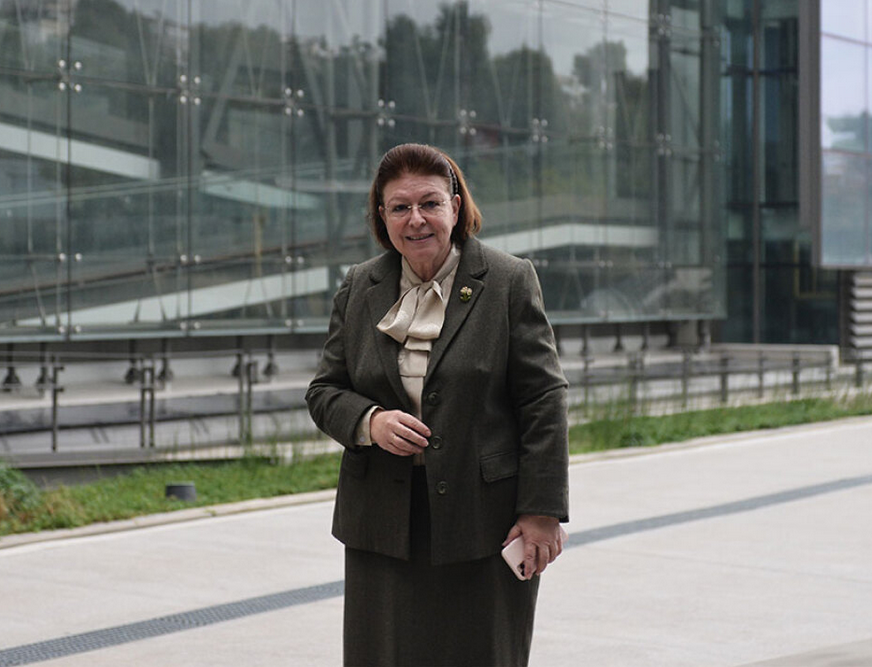
Scene 5: The Funding Programs
DIMITRIS DANIKAS: You have a great deal of effectiveness, that’s impressive. But let’s move on to contemporary culture, where there seems to be a gap. I don’t see much happening. I would, in fact, give you top marks for archaeology, but I would give you a conditional pass for contemporary culture.
LINA MENDONI: A lot is happening! First of all, for contemporary culture, there is the Deputy Minister of Contemporary Culture. Today, it’s Iason Fotilas. So, there is someone who takes care of and handles these matters.
D.D.: Tell me something that has been done.
L.M.: Right now, we’re at the National Gallery. The National Gallery is contemporary culture.
D.D.: Yes, but that’s a project by the Niarchos Foundation, it says so outside.
L.M.: It doesn’t say that. It says that the Niarchos Foundation contributed significantly to the National Gallery.
D.D.: They paid for it.
L.M.: The cost of the Gallery was 60 million. The Niarchos Foundation’s donation was 13 million. The rest were funds secured by the Greek Government, the Ministry of Culture, from its budget and from EU programs.
D.D.: Yes, but again, we’re talking about museums, that’s what I’m trying to say.
L.M.: Why, does contemporary culture not have museums? When did the EMST (National Museum of Contemporary Art) open?
D.D.: It’s empty, I’ve been there. A beautiful, empty space.
L.M.: The EMST has significant works. Whether we like modern art or not is another story. At the EMST, Ms. Gregou and her team have done excellent work. The EMST was closed for 20 years.
D.D.: It’s a cold thing.
L.M.: It may not appeal to someone, but that doesn’t mean it’s empty. The EMST operated under our government, it had been inactive for 20 years. Let’s look at all the infrastructures. The National Opera, the orchestras…
Scene 6: “The Return of Antiquities”
D.D.: What is the prospect beyond the Parthenon Sculptures? Are we seeing the return of other monuments?
L.M.: Over the past five years, hundreds of antiquities have been returned and continue to be returned systematically.
D.D.: From where?
L.M.: A great many from America. Because we’ve invested a lot in the repatriation of cultural goods, several hundred antiquities have returned from America, which had been unlawfully exported there.
D.D.: Can you give me an example?
L.M.: From a specific private collection, in cooperation with the Deputy District Attorney of New York, 47 antiquities were returned. They ranged from Cycladic figurines to classical reliefs and a torso of a kouros.
D.D.: Were they stolen?
L.M.: No, they were illegally exported. They had left as part of antiquities trafficking some years ago. This person bought or acquired them in some way, without any proof of legality. Similarly, from the Simms-Michailidis case—the well-known case of Schinoussa—more than 700 items were returned in 2023. Right now, the Ministry of Culture is systematically claiming unlawfully exported antiquities, both from museums and private collections. This is a critical point in our policy. Another thing that matters to us a lot is to complete the largest cultural infrastructure project that involves both contemporary culture and cultural heritage throughout the country. Right now, we have over 830 construction sites across Greece. Starting with the creation of the National Museum of Underwater Antiquities at the Silos of Piraeus.
D.D.: What stage is this at?
L.M.: Right now, the contractor is transforming the Silos building on the Piraeus quay into a museum space. It will open in 2026. The project is ongoing, a 94-million-euro project. Another example: The State Conservatory of Thessaloniki. An excellent, eclectic building, one of the few that survived the 1917 fire in the historic center of Thessaloniki. The building and the entire infrastructure of the Conservatory are being restored.
D.D.: When will it be ready?
L.M.: By the end of 2025. Just like all the projects that fall within the funding limits of the Recovery Fund and are being implemented with its resources: the Palaces and other Museums at the Tatoi estate, the Marblecraft School in Panormos, Tinos, the conference and cultural center of the European Cultural Center of Delphi, the State School of Orchestral Arts, the Fabric Center in the VEM complex in Monastiraki, the digital transformation of cultural organizations supervised by the Ministry of Culture, our interventions in the Medieval City and the National Theater of Rhodes. By the end of 2025. These and many more…
Ask me anything
Explore related questions

